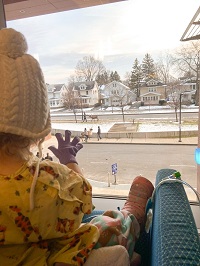About Us
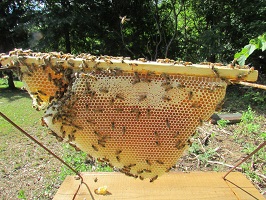 Honeycomb: work in progress!
Honeycomb: work in progress!
We are a tiny little farm in a tiny little town in Western New York. We started a small a herd of reindeer in 2017. Why reindeer? Well... who wouldn't want a pet reindeer? These gentle, social animals enjoy following us around as we work in the pasture and add a sense of wonder to our days. Today we share the joy by bringing our pets out to community events and hosting events on the farm.
While we added reindeer to our farm in 2017, the story really begins in 1994 when we bought 25 acres of corn field and built our home in the middle of the lot while raising our family.
 Mandatory treat inspection
Mandatory treat inspection
Through the years we converted the land into our own little hobby farm. We planted hundreds of trees, dug a few ponds and enjoyed our little slice of the world as the kids grew up. We have raised turkeys, pheasants and peacocks. We have "pet" chickens. We maintain 2-6 honeybee hives, the numbers depending on the winter losses. And we have been making a token amount of maple syrup in our little wood-fired sugar shack for many years. We sell the little bit of honey and syrup at our "Weihnachtshutte" but the eggs we give away.
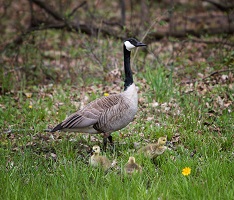 Beautiful wild goose and goslings
Beautiful wild goose and goslings
Our latest addition to the farm started on Christmas Day, 2015. After reading an article online about various reindeer owners in the lower 48 and attending a ROBA (Reindeer Owners and Breeders Association) conference, we decided that a few reindeer would make a nice addition to our farm. Over the next few years, coordinating with local, state, and federal agencies as well as several veteran reindeer owners, we cleared a few acres of brush, planted grasses reindeer could eat, built fences, constructed a barn and got ready to accept our first two reindeer.
In September of 2017 we were able to achieve the goal and welcomed the arrival of two bull calves, Moose and Little Buddy. Since then we have steadily added to the herd with reindeer from Alaska, and eventually welcomed a new calf born here on the farm.
What we do
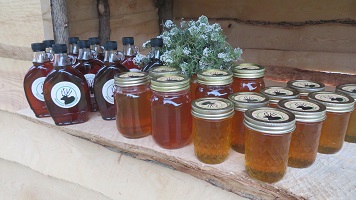 Tasty, tasty hobbies
Tasty, tasty hobbies
Unlike our chicken, honey, and maple syrup hobbies which we still currently enjoy, the reindeer "business" is proving to be a little bit more extensive than planned. If you've ever read the book "If You Give a Mouse a Cookie" you'll know exactly what I mean.
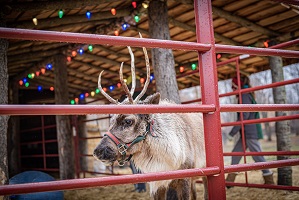 I don't know how this little guy got here
I don't know how this little guy got here
If you give a mouse a reindeer, chances are he'll want a new barn. If you give him the barn, chances are he'll want to put lights in it. If you let him put lights in it, chances are he'll also want a water line to it. If you give him all that, chances are he'll want to invite guests out to see it. If too many guests are interested, chances are he'll want to take the reindeer out to festivals. If you let him take the reindeer out to festivals, chances are he'll want a new trailer to transport them. If you give him a new trailer chances are he'll want a new truck to pull the trailer. And if more and more people want to see the reindeer, chances are he'll want more reindeer. And on and on it goes.
So, all these cookies aren't exactly free. To help defray some of the costs, we host seasonal activities, photo shoots, and private group visits at the farm (see our events). We offer "reindeer for hire" for your festivals, company parties, and more. (learn about hiring the reindeer).
In the News
- 'It’s like I’m a kid again.' Finger Lakes reindeer farm brings Christmas magic to life Rochester Democrat and Chronicle 8 Dec 2023
- A Shortsville Farm gives the North Pole a run for its money Life in the Finger Lakes Magazine Nov-Dec 2022
- Family Adventures in New York State: Shortsville Reindeer Farm Adam and Kimberly Crawford, Dec 2021
- They flew like reindeer in Shortsville and Manchester Mike Murphy, Rochester Democrat & Chronicle 24 Dec 2020
- Reindeer at Golisano Children's Hospital News 8 WROC 24 Dec 2020
- 'Tis the season to visit Ontario County's reindeer farm John Kucko, Rochester First 3 Dec 2020
- Meet Ontario County's Resident Reindeer Home in the Finger Lakes 11 Nov 2019
- Santa's tiniest reindeer healthy for Christmas Will Cleveland, Democrat & Chronicle 22 Dec 2017
Questions & Answers
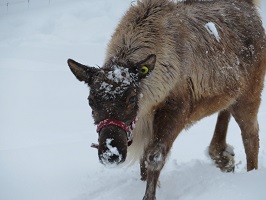 This is totally normal
This is totally normal
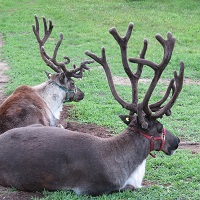 This is also totally normal
This is also totally normal
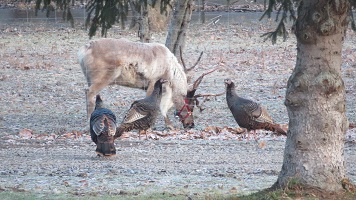 Some friends stopping by to chat
Some friends stopping by to chat
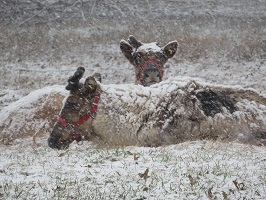 Perfect weather for sunbathing
Perfect weather for sunbathing
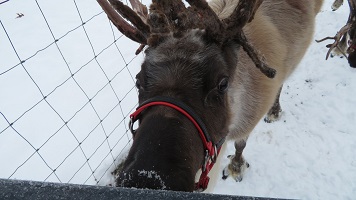 Look at those toes!
Look at those toes!
 Baby reindeer need training to eat treats
Baby reindeer need training to eat treats
- Can I pet the Reindeer?
- Yes, you may, under the direction of the handler. The best place to pet the reindeer is on the sides. They don't like their heads, noses, or antlers to be touched. Touching them in those places tend to make the reindeer shake their heads. And with those big pointy antlers, that can be dangerous.
- When do they lose their antlers?
- Both males and females lose their antlers every year and grow new ones. Antlers grow very quickly to full size within about 3-4 months. Every year until maturity the antlers get bigger. Full maturity is reached in 4-5 years. Males generally (not always) lose their antlers in November or December. Females in March or April. Castrated males can lose their antlers from December to March.
- What is the fuzzy stuff on their antlers?
- The fuzzy stuff is called velvet. The velvet contains living tissue full of blood vessels and nerves. It is the blood vessels which provide the nourishment for the growth of the antlers. Kind of like a bone inside out. The antlers grow from the tip, not the base, like a tree. When the antler is full grown the velvet will dry up and the reindeer will rub it off on trees and shrubs.
- Are they like "regular" deer?
- I would say they are more similar to cows. Reindeer are very docile and will allow you to stand right next to them. Reindeer do not jump like whitetail deer. Reindeer can be easily trained to walk on a leash. Whitetail deer are wild, reindeer are semi-domesticated.
- Are they called bucks, does, and fawns like regular deer?
- Actually, they are classified more like cattle. A young male is a bull calf. A young female who hasn't given birth is a heifer. An older male is a bull and an older female is a cow. A male that has been castrated or neutered is called a steer.
- Aren't they really just caribou?
- Reindeer and caribou are different sub-species of the same species, Rangifer Tarandus. Caribou are native to North America, and are wild. Reindeer are native to Europe and Asia, and have been semi-domesticated for thousands of years. Generally reindeer are shorter and stockier than caribou.
- Do they kick like horses?
- Reindeer do not. When little kids approach the reindeer for safety purposes we tell them to approach from the sides or back. If you approach from the front the reindeer tend to lower their heads and consequently those big antlers come down as well.
- What do the reindeer eat?
- The reindeer will graze on broadleaf grasses (not grasses with woody stems), leaves, and some small twigs. They love willow which provides a source of protein for them. You may also see them eating dirt from time to time. We also feed our reindeer a special deer food made by Purina. You can see the pellets in their feed trough.
- Can they swim?
- Reindeer are excellent swimmers. Their very thick coats (they have two, a soft downy undercoat and longer stiffer guard hairs) have hollow hairs that make them very buoyant. And their feet (hooves) are very large enabling them to run more easily in the deep snow and to swim very fast, faster than Michael Phelps.
- Where do they come from?
- The first reindeer in the United States were imported from Scandianavia to Alaska in the 1800s to be raised as a source of food. The Sami people of Lapland (parts of Scandinavia and Russia) still maintain large herds of reindeer. The Sami were traditionally nomads who moved with the herds as the reindeer migrated to find food. Reindeer farms exist throughout the United States as far south as Texas. However, they don't like the warm weather as much so some southern farmers have air-conditioned barns. Most farmers have large fans in their barns to keep the reindeer cool on hot days and to keep the flies off them.
- How long do they live?
- In captivity they tend to live longer than in the wild. Bulls generally from 10-12 years, cows about 15 years, and steers a few years longer. Some reindeer have lived into their 20s.
- How much do they cost?
- A lot of that depends on where you live, how old the deer is and what the sex of the deer is. Cows are often more expensive than bulls. Most reindeer probably cost between $10,000 and $20,000 dollars.
- Do you have to trim their toes?
- Yes, their toes do need to be trimmed from time to time. I use "goat sheers" to trim them. The front of the hooves should not cross. I also trim away any areas that have cracks or cuts so bacteria/fungus don't get in the cracks and get infected.
- How big do they get?
- The bulls can get over 500 pounds, the cows much smaller. A lot of their size is determined not only by genetics but also the availability of nutritious food sources.
- How fast do they run?
- Reindeer have been known to run up to 40-50 miles per hour, faster than Usain Bolt.
- How do they defend themselves?
- Though reindeer can have large intimidating antlers, their primary means of defense against predators is to run. The bulls use their antlers most often in the breeding season (the rut) when they fight with each other to defend their harem of cows. Bulls in rut are dangerous animals. They are dangerous to other bulls, to cows, to people. Many reindeer owners who breed reindeer will cut off the bull's antlers as soon as they shed their velvet and right before the rut. Some also will give their bulls hormones (depo-provera) to keep the bulls from fighting and potentially killing each other.
- Is it hard to keep them healthy?
- Reindeer are very susceptible to parasites and viruses in areas were the reindeer are not native. Ticks are a major concern to reindeer owners is some areas of the country. Whitetail deer also are hosts to certain nematodes which are harmless to the whitetail but will cause neurologic disorders and eventual death to reindeer. Sheep and goats also reservoir hosts for a virus that will kill reindeer. Some recommend not having sheep/goats within half-mile of reindeer because once the virus is shed it becomes airborne. In this area we have lots of ticks, whitetail deer and goats. One of our reindeer spent 2 weeks at the Cornell veterinary hospital fighting a tickborne disease (Babesia) that was attacking his red blood cells. After a protocol of a very selective medicine and a blood transfusion from his healthy brother, he was able to beat the disease.

